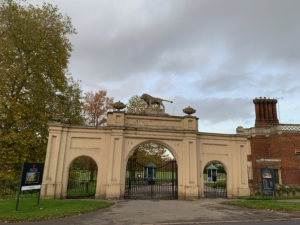Saturday 18th November 2023
Guidebook: 10.6 miles
My Garmin: 14 miles (including labyrinth and getting a bit lost)
After fuelling up with eggs and avocado on toast, I don my new coat and waterproof trousers. The two rejected-as-insufficiently-waterproof coats are crammed determinedly into my backpack. There’s not a lot of space. Of course, when I venture outside, the rain has virtually stopped. Yesterday’s dire forecasts of incessant downpour have been upgraded to occasional showers. Still, I’m sure my new wet-weather equipment will come in handy, sooner or later.
Saffron Walden market square is busy again, this time with a tempting array of stalls selling fresh fruits and vegetables, pastries, olives, cured meats, leather goods and clothing. Everything looks delicious; I almost wish I’d eaten less breakfast! Saffron Walden is clearly still very much a market town; in fact this market has won awards.[i] TV chef Jamie Oliver lives nearby and apparently shops here regularly, though I don’t spot him this morning. It is still pretty early.

Finding the Labyrinth
Before leaving Saffron Walden, I am determined to find the labyrinth. I was impressed to read last night that the town has several mazes. There’s a hedge maze, a brick labyrinth, a paved maze, a maze sculpture in the local art gallery, and a turf labyrinth dating from the seventeenth century, or possibly earlier. [ii]I have always loved a good maze, and a labyrinth is supposed to be a sort of mini-pilgrimage, so it seems particularly appropriate that I should check out this one.
I find the labyrinth at the far end of the Common, a large grassy area close to the town centre. It’s a circular arrangement of snaking paths cut into the turf, with a raised mound in the centre and blobby half circles on each of four sides. I’m surprised how small it looks, given that its path is 1500 metres long.
Whereas a maze presents you with repeated choices of right and wrong turnings as you seek your way through it, a labyrinth is one long continuous path folded in on itself. Like a pilgrimage, walking a labyrinth is often thought of as an aid to meditation and contemplation. There are labyrinths in many ancient cultures, including the one with the Minotaur in Greek myth, and a Christian one on the floor of Chartres Cathedral in France.[iii] The Saffron Walden labyrinth has been here for hundreds of years, and is the biggest example of its type in the world.[iv]
I check my watch. I’ve got a long hike to do today, in questionable weather. Can I really afford to add on an extra mile or so walking round and round in circles before I even get started? And will that man over there throwing sticks for his dog think I’m a bit of a weirdo? I almost don’t bother, but then decide I might as well at least start. I’m here after all …. Once I begin, I find I can’t stop.
(When you get to the end of this blog you can read the poem I wrote about walking the labyrinth. It turned out to be an experience for poetry rather than prose.)

I finally and rather reluctantly leave Saffron Walden, the labyrinth experience very much still with me. I add this delightful town to my mental list of ‘places I would like to live when we retire’. It seems to have everything: historic charm, good shops, friendly people and proximity to a mainline train station. But for now I have a pilgrimage to be getting on with. I head up a hill through a housing estate and find the Harcamlow Way on an extremely muddy path across fields full of sugar beet. It’s scarcely drizzling, and my new coat is proving much hot, but I can’t fit it into my backpack, so this may well turn out to be a rather sweaty day.
Soggy Underfoot
I follow farm tracks and squelch through soggy mud, passing a couple of farm Landrovers and a few people setting up for a day’s shooting. As I approach the hamlet of Church End, I reach a lane that is completely flooded for a stretch of maybe fifty metres. Grateful for my waterproof boots and trousers, I manage to scramble along the bank and reach a patch of grass at the other end where I’m amazed to see two women pitching a tent. Surely no one is out camping in this weather? I say hello, and they turn out to be a couple of intrepid Scout and Guide leaders setting up an aid station for a Marathon Hike event which is going on today. They are very friendly, and I compliment them on their commitment before continuing across a field on the edge of a wood.
I have already noticed deer footprints in the mud, and here dozens of fallow deer are grazing under mighty oak trees. It’s a lovely sight after the rather dull farmland. The deer amble away into the edge of the wood as I pass, but I’m sure they’ll be out again to munch on the grass again as soon as I’ve gone.
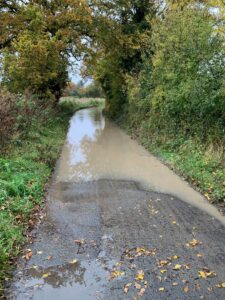
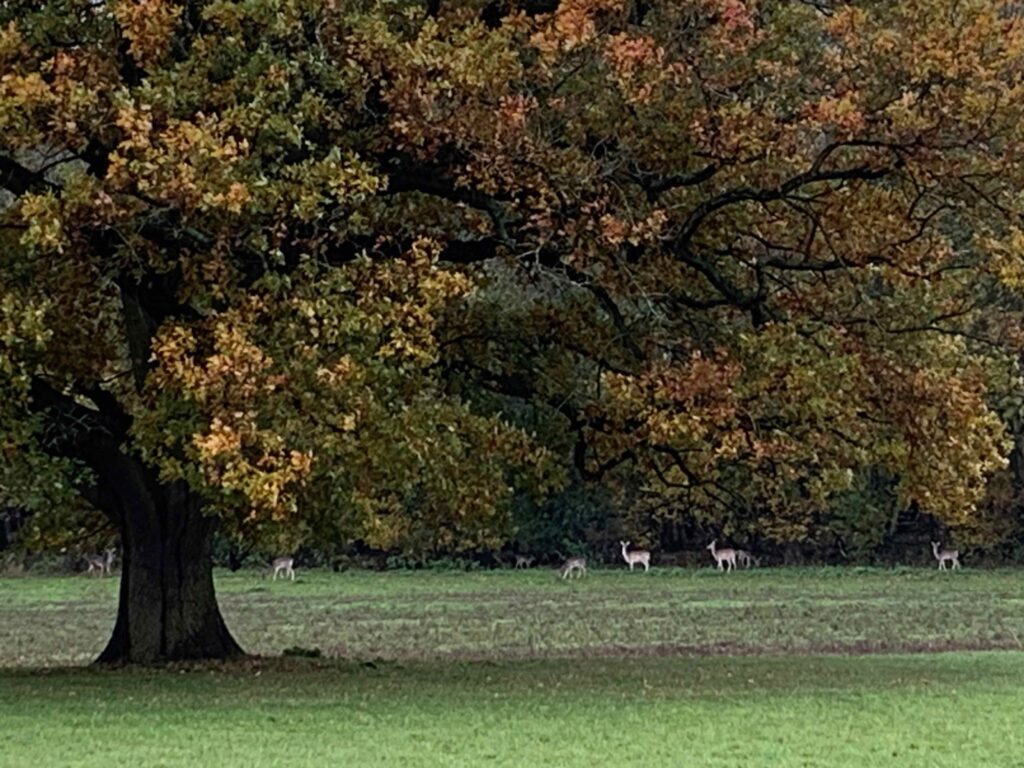
An open church and a poem
Church End and Ashdon makes up a double village with the little River Bourn running through the centre. All Saints’ church is charming and very old, dating from the eleventh century. I’m happy to find the church unlocked, with a Walsingham Camino pilgrim stamp for my passport next to the visitor’s book. I sign the book, noting as I do so that other Camino pilgrims have passed this way just a few weeks before me. It’s great to feel that sense of accompaniment – that I’m not entirely crazy or alone doing this.
Someone has left copies of the poem The Bright Field by R S Thomas in the church. Thomas is one of my favourite poets, and this little poem seems to speak especially today to my pilgrimage experience and my labyrinth meditations this morning:
‘Life is not hurrying
on to a receding future, nor hankering after
an imagined past. It is the turning
aside like Moses to the miracle
of the lit bush, to a brightness
that seemed as transitory as your youth,
but is the eternity that awaits you.’

Mud, Scouts, and a windmill
There’s a little village museum in Ashdon which looks fascinating, but unfortunately it’s closed for the winter. So I leave the village and carry on up more hills on very slippery mud. It still isn’t raining, but the drainage ditches are pouring torrents, and everything everywhere is sodden. My waterproof overtrousers are thickly spattered with mud up to my thighs and doing a fabulous job. A few little groups of Scouts pass me as I climb towards a white weatherboarded post windmill. I pause here to take a photo and admire the view, and then it’s downhill again to Ashdon Place.
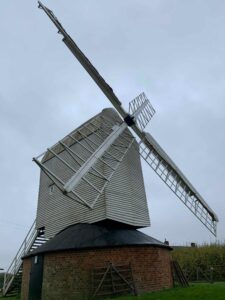
Horses, but no signs
Whoever owns this very grand and manicured estate doesn’t seem very keen on walkers, as the helpful Harcamlow Way signs I’ve been following all day are absent here. There’s a big house, and lots of horses in paddocks. I feel a bit nervous walking up what feels like a private drive, even though it’s clearly shown as a right of way on my map. But I pass a groom leading two horses, and she gives me a friendly smile.
Some of the young wheat shoots in the fields are turning yellow; I’m no farmer, but I wonder if it’s due to the waterlogged soil. Some of the lower-lying areas are completely underwater. I slip and slither my way towards the next village of Bartlow where I cross from Essex into the corner of Cambridgeshire. Here I spot another Scout aid station before turning off the road up a little footpath to find the Bartlow Hills Tumuli.
Bartlow Hills Tumuli
There’s a video on YouTube called The Pyramids of Essex all about the Bartlow Tumuli if you’re interested. The tumuli are big Roman burial mounds, about 45 feet high. You can visit three of them, but there used to be seven or eight; the others have been reduced or obliterated by farming and railway building over the centuries. They were excavated in the nineteenth century, and many fascinating artefacts were found, including wooden chests, cremation remains, iron lamps and decorated pottery, but sadly very few of these survive today. The mounds themselves are wonderful, though – impressively big and mysterious, and hidden away in the woods.[v]
Andy Bull, the author of my guidebook, says he scrambled up one of the mounds, so I decide I should follow his lead. The sides are very steep though, with nettles growing in places, and it’s tricky to get a foothold in all this mud. I almost think better of it, but if Andy did it … Not to be outdone, I fling myself at one of the slightly smaller side mounds, grasping at tufts of grass and covering myself in mud as I claw my way up. It’s only when I’m standing on the top, panting for breath, that I look across and see a wooden staircase leading all the way up the far side of the biggest mound. Andy probably went up that way!
Feeling a bit foolish, I survey the view from up here before contemplating how on earth I am going to get down. The only way, I decide, is to slide on my bottom. Thank the Lord for these waterproof trousers! Looking doubtless very undignified, and catching my thumb painfully on a thorn, I slither rapidly all the way back to level earth. Now ‘muddy’ is entirely inadequate to describe the state of my clothing.
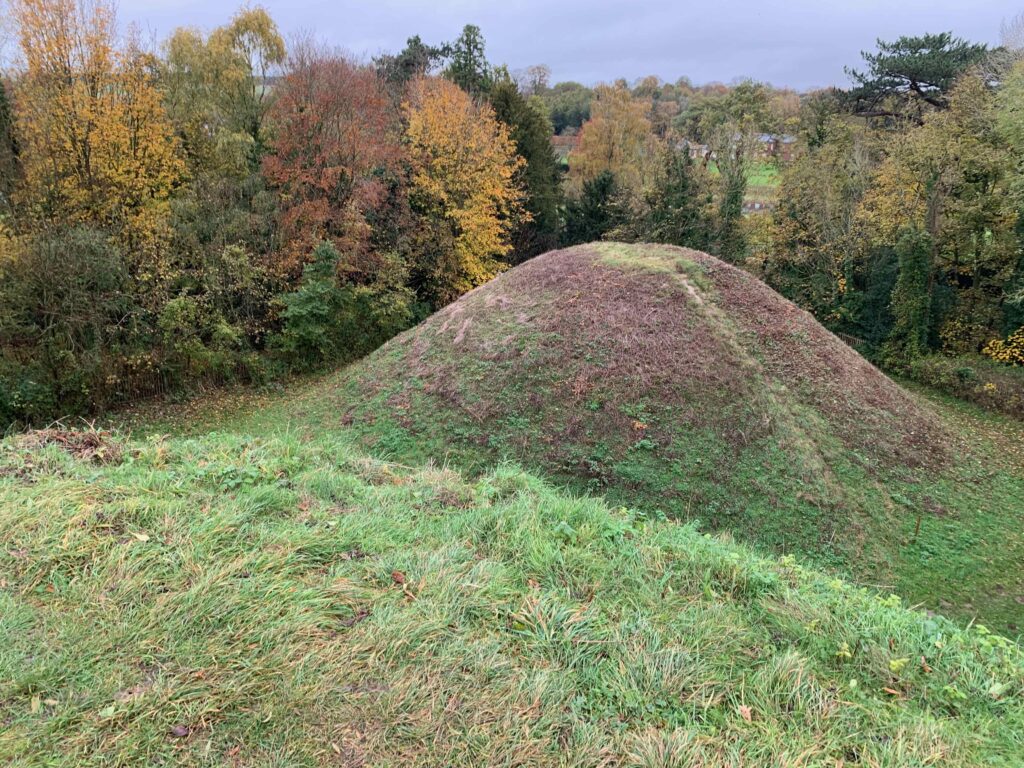

Too grubby for the pub
There’s a pub in the village – the Three Hills Gastro Pub – and I had considered having lunch here. But I’m not really hungry after my massive breakfast, and when I stick my head inside the very clean and rather elegant establishment, I decide I’m too grubby for a smart place like this. Instead, I go round the corner to the village church. Even mud-coated, trail-stained pilgrims are welcome in God’s house.
It turns out to be a good call; the church is wonderful. Dedicated to Saint Mary, it’s a medieval gem, decorated with fifteenth century wall paintings of Saint Christopher, patron of travellers, Saint George’s dragon, and Saint Michael weighing souls in a balance. The Saint Michael picture shows the devil trying to drag human souls down to hell, but the Virgin Mary has her hand on the other end of the scales, thwarting his efforts – a lovely image of God’s mercy that I’ve never seen before. I spend some time reading the fascinating signboards about the history of the church, which is also notable for its rare round tower.[vi] The hand gel provided comes in useful for cleaning my dirty hands, and there’s a pilgrim stamp for my passport too.
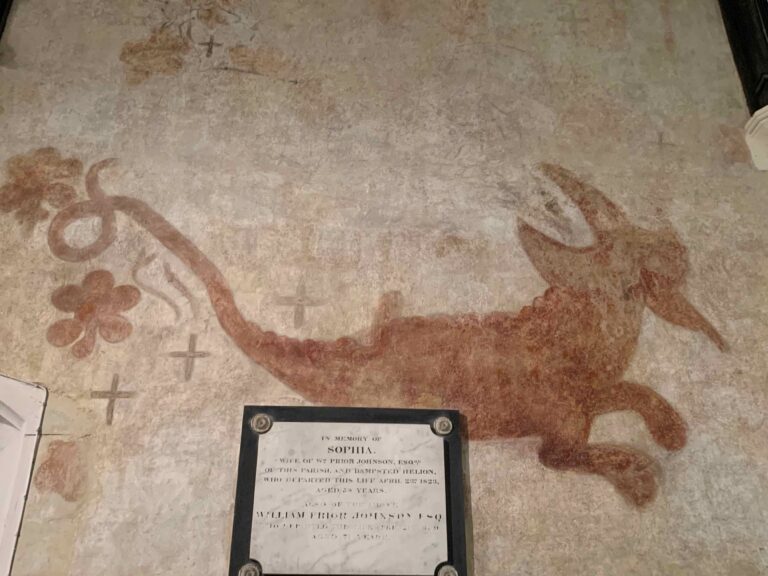
Feeling refreshed, I set off again over yet more muddy hills towards my final destination of the day. I take a wrong turning, and get a bit lost, and a bit thirsty in my too-warm coat, but the waterproof trousers come into their own yet again when I sit down on the damp ground to drink from my water bottle and eat an energy bar. A pair of red kites circles over a nearby spinney. Walking between hedgerows, I notice that the hawthorn bushes are thickly berried with dark red haws and recall the May blossom I saw back in that month on the earlier stages of this walk. The flowers have turned to fruit while I’ve been busy doing other things.
At last, a concrete farm track takes me over the busy A1307 and into the village of Horseheath. I check out the Anglican parish church of All Saints. It’s locked up, but there’s a service here tomorrow morning which I plan to attend as I won’t be able to get to a Catholic Sunday mass from this remote spot. Feeling sweaty and weary, I turn towards the Old Red Lion pub where I have a room booked for tonight. It’s still only two pm, so I’m very grateful to be allowed straight into my accommodation. Even better, there’s a bathtub!
It takes me a while to wash the worst of the mud from my very hard-working waterproof trousers and hang them up to dry. They have become my new best friends. Then it’s into the bath myself for a long and luxurious soak. Day six, done!
[i] https://www.visitsaffronwalden.gov.uk/saffron-walden-market/
[ii] https://www.visitsaffronwalden.gov.uk/wp-content/uploads/2019/10/Saffron-Walden-Mazes.pdf
[iii] https://earthandaltarmag.com/posts/qs6pevk77i0lhpqlvv8w0u23f1sbwk#:~:text=A%20labyrinth%20is%20an%20ancient,a%20wide%20range%20of%20materials.
[iv] https://labyrinthos.net/C41%20Saffron%20Walden.pdf
[v] https://thelostbyway.com/2016/05/pyramids-essex-bartlow-hills.html
[vi] http://www.druidic.org/camchurch/churches/bartlow.htm
Walking The Labyrinth
I wondered if it would be a waste of time to walk the labyrinth,
it’s just going round
and round in circles, after all, and getting
nowhere, following the narrow path and turning
back on myself, and back again, returning,
tracing the loops, one foot in front of the other, turning
again, but as I walk I begin to realise I’m humming
a little tune, getting into a rhythm in time
with the step of my feet, settling
into the pace of the path, and the constant turning,
beginning to recall something similar, other returning
journeys, like trying and trying again to
write a novel, or build a friendship, or mother
a child, or other things in life requiring
repetition, this returning
over and back again and again into some sort of becoming
which is never the thing I first looked for, but always another turning,
and turning again, and again, and the labyrinth leads me
into the outside loops, which are larger, recalling
life’s larger events, births and parting, but always returning
back to the inner paths and the soothing pattern
still leading me round and around
and gradually inward, still turning, until
when I would have been happy enough to continue,
I find myself turn for the last time, into the centre,
the end,
which is raised on a little hill, like heaven perhaps,
or a burial mound,
and it’s done, but not
done, and I walk away, returning
into the rest of my day, and all day I find myself wondering
whatever I thought I meant
by a waste of time.




